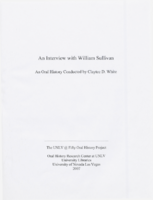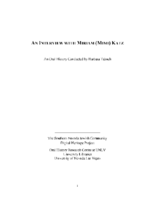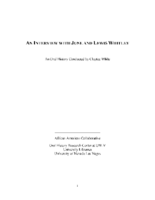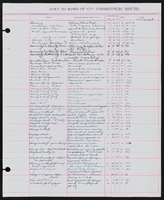Search the Special Collections and Archives Portal
Search Results

Transcript of interview with Dr. William Sullivan by Claytee D. White, December 20, 2006
Date
Archival Collection
Description
Interview with Dr. William Sullivan conducted by Claytee D. White on December 20, 2006. Sullivan was recruited by University of Nevada, Las Vegas in 1978 to be Director of Student Support Services. Born and raised in Chicago, Illinois, Sullivan earned his doctoral degree from University of Utah, where he helped open the Minority Center. As President of the Utah Association of the National Council for Black Studies programs, Sullivan designed minority recruiting strategies for universities.
Text

Transcript of interview with Miriam "Mimi" Katz by Barbara Tabach, December 10, 2014
Date
Archival Collection
Description
In this interview, Mimi Katz discusses growing up in the Boston area and her schooling, and moving to Washington, D.C. working as a physiotherapist. She returned to Boston and met her husband, and she talks about moving to Las Vegas and adjusting to life here. They became involved at Temple Beth Sholom, and Mimi worked as a conventions coordinator at the Sands and the Sahara. She discusses moving around in Las Vegas from an apartment to a house in the John S. Park neighborhood, working for the Jewish Federation, and helping to develop the Holocaust education program with Edythe Katz, conducting oral history interviews with survivors. She continued working at the Convention Center in the 1980s, and is involved in the Lou Ruvo Center.
Everyone knows her as Mimi. She was born Miriam Green to immigrant parents in Boston, Massachusetts, in 1926. As a youngster she danced, excelled at school and enjoyed an abundance of sports. To pay for her higher education at Massachusetts School of Physiotherapy she worked at Raytheon Manufacturing. In 1957 she married George Katz who swept her away to their honeymoon in Las Vegas. It's a story that she loves to recall-they never left. She sent for her things and energetically settled in to her new hometown and marriage. Mimi found employment with the Clark County School District, began having children (three daughters), and making fast new friends. Many of these friends were from the founding days of Temple Beth Sholom, which roots her to the history of the local Jewish community. In addition, for a decade she worked in community relations for the Jewish Federation. She valued community activism and volunteered over the years for many organizations; such as Easter Seals, Jewish War Veterans, Parent Teachers Association and the Lou Ruvo Center for Brain Health, and many more organizations over the subsequent decades.
Text

Transcript from interview with Rejoyce Williams by Claytee White, June 12, 1996
Date
Archival Collection
Description
Rejoyce Williams moved to Las Vegas with her husband and their six children in 1960. Williams grew up in Fordyce, Arkansas, and has also lived in California. When she arrived in Las Vegas, she worked as a maid at the Las Vegas Hilton and participated in the Culinary Union strike in 1970. In the interview, she discusses her involvement in church activities, and other anecdotes from her employment.
Text

Transcript of interview with Essie Shelton Jacobs by Claytee D. White, February 1, 1996
Date
Archival Collection
Description
Interview with Essie Shelton Jacobs conducted by Claytee D. White on February 1, 1996. Jacobs arrived in Las Vegas 1963 and worked in housekeeping at Aladdin Hotel for twenty-three years. Active in the Culinary Workers Union Local 226, she worked as a supervisor and shop steward.
Text

Transcript of interview with June and Lewis Whitley by Claytee D. White, November 2, 2007
Date
Archival Collection
Description
Transcript of interview with June and Lewis Whitly by Claytee D. White on November 2, 2007. June and Lewis Whitley moved to Las Vegas as newlyweds in 1958. June worked as a maid and then found a position with Centel Telephone and was on the Board of the Clark County Community College. Lewis worked at Test Site as a cook and later for the Clark County Fire Department.
Text

Transcript of interview with Nathaniel Whaley by John Grygo, March 6, 2013
Date
Archival Collection
Description
Interview with Nathaniel Whaley by John Grygo on March 6 and March 8, 2013. Whaley talks about growing up in Las Vegas and his adult life on the Westside. Nathaniel had a successful high school career as an accomplished athlete and Eagle Scout in the first black Boy Scout troop in the area. Nathaniel would go on to have a fruitful career as a mason and contractor, literally helping build the city of Las Vegas.
Text

Transcript of interview with Sarann Knight by Yvonne Hunter, July 16, 1975
Date
Archival Collection
Description
Interview with Sarann Knight [Preddy] conducted by Yvonne Hunter on July 16, 1975. Preddy moved to Hawthorne, Nevada, in the 1940s, becoming a business owner and president of the NAACP. Later she moved to Las Vegas, where she served as a community activist and worked as one of the first black 21-dealers.
Text

Transcript of interview with Lucille Bryant by Claytee D. White, December 13, 1995
Date
Archival Collection
Description
Interview with Lucille Bryant conducted by Claytee D. White on December 13, 1995. Moving to Las Vegas in 1953 from Tallulah, Louisiana, Bryant worked in the housekeeping departments of the Algiers Hotel, the Silver Slipper, the Sands, and the Stardust. Bryant provides an overview of pre-Civil Rights era conditions in Tallulah and Las Vegas including housing, schools, and working conditions as well as her experiences with the Culinary Workers Union Local 226.
Text

Transcript of interview with Jackie Brantley by Claytee D. White, October 27, 1996
Date
Archival Collection
Description
Interview with Jackie Brantley conducted by Claytee D. White on October 27, 1996. Born in Las Vegas following World War II, Brantley grew up on the Westside. Beginning as a public relations specialist for Desert Inn Hotel and Casino, Brantley later worked as a model and supported the development of Nucleus Business Plaza.
Text

